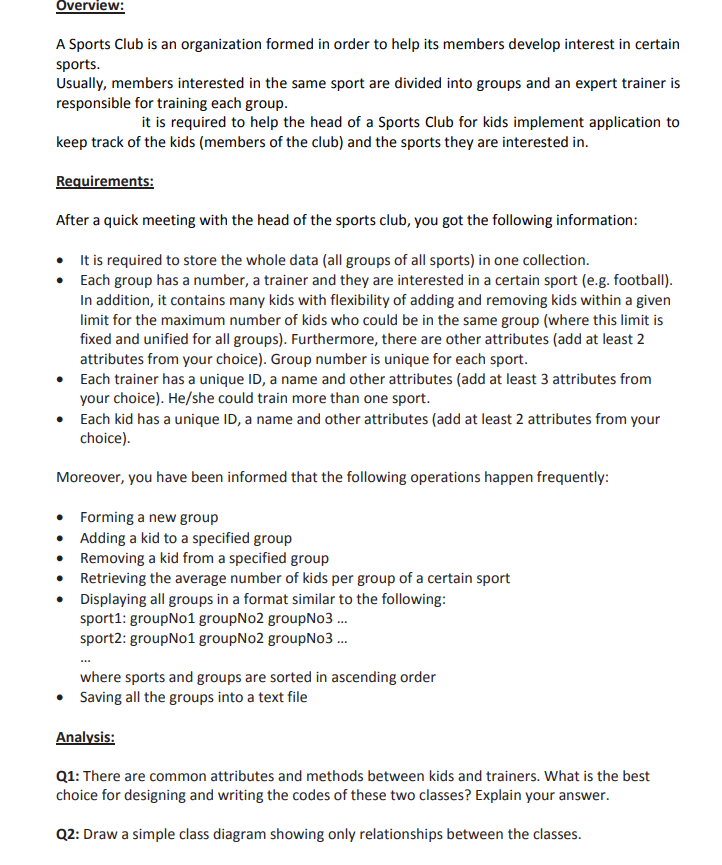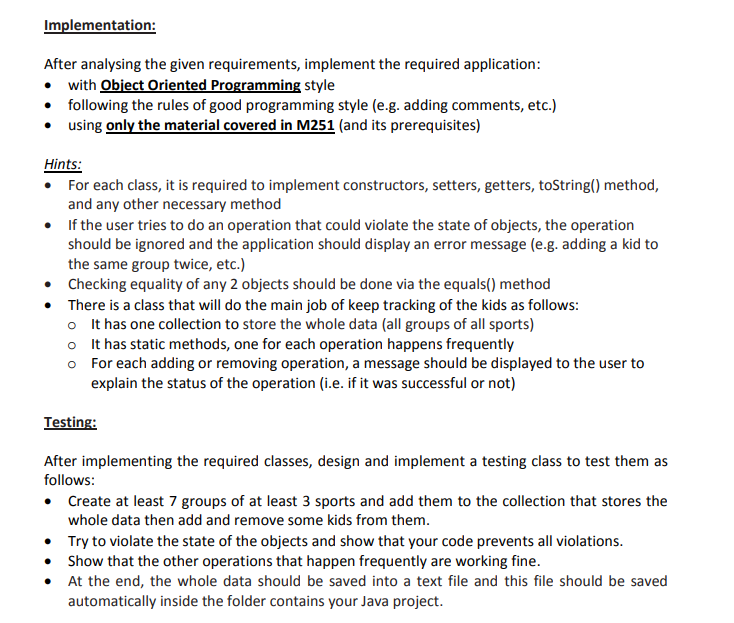do the changes in this program according to the given instruction like coaches instead of teachers,sports name instead of courses etc, import java.util.*; class CourseManager{ //toatl students each section can hold static int max_Students; //mapping of each sections w.r.t to course HashMap > courses ; //constructor for CourseManager public CourseManager(int max){ max_Students = max; courses = new HashMap<>(); } //class Person which will be used by teacher and students to inherit its properties static class Person{ String name; int age; public Person(String name , int age ) { this.name = name; this.age = age; } } //teacher class static class Teacher extends Person{ int id; public Teacher(int id , String name , int age ) { super(name , age ); this.id = id; } } //student class static class Student extends Person{ int id; public Student(int id , String name , int age ) { super(name , age ); this.id = id; } } //section class static class Section { int section; String course ; Teacher instructor; int size ; HashMap students; //constructor public Section(int section , String course , Teacher instructor) { this.section = section; this.course = course; instructor = this.instructor; students = new HashMap<>(); this.size = 0; } //function to add students public void addStudent(int id ,Student s1) { if(students.containsKey(id) || size == max_Students) { System.out.println("Adding student to Section is not succesful"); } else { students.put(id ,s1); size++; System.out.println("Adding student to Section is succesful"); } } //function to remove student public void removeStudent(int id ) { if(!students.containsKey(id) || size == 0) { System.out.println("Removing student from Section is not succesful"); } else { students.remove(id); size--; System.out.println("Removing student from Section is succesful"); } } } // function of course manager to map section with their courses public void addSection(String course , Section s) { if(!courses.containsKey(course)) courses.put(course,new ArrayList()); courses.get(course).add(s); } //function to display the section w.r.t its courses public void DisplaySection() { for(String key : courses.keySet()) { System.out.print("Courses with sections : "); for(Section s : courses.get(key)) { System.out.print(s.section +" "); } System.out.println(); } } public static void main(String args[]) { //course manager object CourseManager cm = new CourseManager(2); //some students object Student s1 = new Student(123,"John",15); Student s2 = new Student(456 , "Paul" ,16); Student s3 = new Student(789 , "Chris" ,15); Student s4 = new Student(901 , "Morris" ,17); //some teacher object Teacher t1 = new Teacher(1234 , "Sophie" , 28); Teacher t2 = new Teacher(1000 , "Alena" , 40); //creating section and mapping them with the courses Section sec1 = new Section(11,"M54",t1); cm.addSection("M54", sec1); Section sec2 = new Section(22,"C11",t2); cm.addSection("M55", sec2); //adding and removing students sec1.addStudent(123, s1); sec1.addStudent(456, s2); sec1.addStudent(789, s3); sec1.removeStudent(123); sec2.addStudent(901, s4); //display the section w.r.t its courses cm.DisplaySection(); } }
do the changes in this program according to the given instruction
like coaches instead of teachers,sports name instead of courses etc,
import java.util.*;
class CourseManager{
//toatl students each section can hold
static int max_Students;
//mapping of each sections w.r.t to course
HashMap<String,ArrayList<Section> > courses ;
//constructor for CourseManager
public CourseManager(int max){
max_Students = max;
courses = new HashMap<>();
}
//class Person which will be used by teacher and students to inherit its properties
static class Person{
String name;
int age;
public Person(String name , int age )
{
this.name = name;
this.age = age;
}
}
//teacher class
static class Teacher extends Person{
int id;
public Teacher(int id , String name , int age )
{
super(name , age );
this.id = id;
}
}
//student class
static class Student extends Person{
int id;
public Student(int id , String name , int age )
{
super(name , age );
this.id = id;
}
}
//section class
static class Section
{
int section;
String course ;
Teacher instructor;
int size ;
HashMap<Integer ,Student > students;
//constructor
public Section(int section , String course , Teacher instructor)
{
this.section = section;
this.course = course;
instructor = this.instructor;
students = new HashMap<>();
this.size = 0;
}
//function to add students
public void addStudent(int id ,Student s1)
{
if(students.containsKey(id) || size == max_Students)
{
System.out.println("Adding student to Section is not succesful");
}
else
{
students.put(id ,s1);
size++;
System.out.println("Adding student to Section is succesful");
}
}
//function to remove student
public void removeStudent(int id )
{
if(!students.containsKey(id) || size == 0)
{
System.out.println("Removing student from Section is not succesful");
}
else
{
students.remove(id);
size--;
System.out.println("Removing student from Section is succesful");
}
}
}
// function of course manager to map section with their courses
public void addSection(String course , Section s)
{
if(!courses.containsKey(course))
courses.put(course,new ArrayList<Section>());
courses.get(course).add(s);
}
//function to display the section w.r.t its courses
public void DisplaySection()
{
for(String key : courses.keySet())
{
System.out.print("Courses with sections : ");
for(Section s : courses.get(key))
{
System.out.print(s.section +" ");
}
System.out.println();
}
}
public static void main(String args[])
{
//course manager object
CourseManager cm = new CourseManager(2);
//some students object
Student s1 = new Student(123,"John",15);
Student s2 = new Student(456 , "Paul" ,16);
Student s3 = new Student(789 , "Chris" ,15);
Student s4 = new Student(901 , "Morris" ,17);
//some teacher object
Teacher t1 = new Teacher(1234 , "Sophie" , 28);
Teacher t2 = new Teacher(1000 , "Alena" , 40);
//creating section and mapping them with the courses
Section sec1 = new Section(11,"M54",t1);
cm.addSection("M54", sec1);
Section sec2 = new Section(22,"C11",t2);
cm.addSection("M55", sec2);
//adding and removing students
sec1.addStudent(123, s1);
sec1.addStudent(456, s2);
sec1.addStudent(789, s3);
sec1.removeStudent(123);
sec2.addStudent(901, s4);
//display the section w.r.t its courses
cm.DisplaySection();
}
}


Trending now
This is a popular solution!
Step by step
Solved in 2 steps with 1 images


